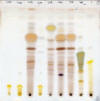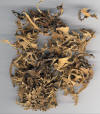|
Niebla and Vermilacinia (Ramalinaceae) from California and Baja
California.
Evolutionary history of coastal species
of fog lichen genera
Spjut R, Simon A, Guissard M, Magain N, Sérusiaux E.
2020. The fruticose genera in the Ramalinaceae (Ascomycota, Lecanoromycetes):
their diversity and evolutionary history. MycoKeys. 73: 1–68,
published online.
Evolution and diversification of Niebla
Additional Discussion: See:
Introduction to
Niebla and its
phylogeography |
||
|
Islas de los Coronados, Palmer 310, holotype for Niebla palmeri (US)
|
TLC for specimens collected in Chaparral-Desert Transition (CDT). 17054-72 near San Quintín, 73-82 SW of El Rosario to Punta Baja: 17054-4695—N. x effusa with salazinic acid (initial run included sekikaic acid, 17062a-4702—N. limicola with salazinic acid,17063-4709—N. palmeri with sekikaic acid & triterpenes, 17064-4710—N. josecuervoi with salazinic acid, 17076-4719—N. undulata with divaricatic acid & triterpenes, 17078-4720—N. palmeri x N. pulchribarbara with protocetraric acid, sekikaic acid & triterepenes (depsidone clade),17079-5060—N. palmeri (x brachyura) 2nd TLC with sekikaic acid & tritepenes (initial TLC included hypoprotocetraric acid, DNA in depsidone clade) 6-loci phylogeny in sekikaic acid clade with N. fimbriata, 17082-5063—N. brachyura with hypoprotocetraric acid and possibly trace of sekikaic acid. Note triterpenes in sekikaic specimens differ in 4709—N. palmeri.
|
ITS and 6-loci phylogenies for N. palmeri. N. aff. palmeri and N. fimbriata. Morphologically different, all chemically similar with sekikaic acid, or with both sekikaic acid and divaricatic acid (N. aff palmeri). Niebla fimbriata and N. palmeri from near San Antonio del Mar, N. aff. palmeri from Bahía de San Quintín, ~ 80 km N of San Antonio del Mar |
  Cited in Diaz-Allen et al. (2021). Spjut & Marin 14395: Pacific Coast: Chaparral-Desert Transition. Mesa with reddish lava east of Punta San Antonio del Mar, west of Colonet; 31°05.403', 116°16.268', 92 m. 11 May 2000. Lichen Substances Det. Cassandra Diaz-Allen and Liva Rakotondraibe, Eight fractions: Sekikaic acid (5 fractions), triterpenes 4 fractions (stictanes-3β,22α-diol, stictane 3,22-dione, undetermined stictanes), usnic acid (2 fractions), and fatty acids (1 fraction) Spjut & Marin 14406. Pacific Coast: Pacific Coast Hwy (1) along the ocean south of San Quintín, east of Mexican Hwy 1 in alkaline hills of coastal scrub; 30°10.55', 116°45.24'55.08, 92 m. 16 May 2000. Lichen Substances Det. Cassandra Diaz-Allen and Liva Rakotondraibe, Nine fractions: Sekikaic acid (1 fraction), triterpenes 2 fractions (undetermined stictanes), usnic acid (4 fractions), and fatty acids (1 fraction).
|
Draft ITS phylogenetic tree showing N. fimbriata and N. palmeri species complexes |
Niebla palmeri x N. pulchribarbara
(salazinic & fumaroprotocetraric acids, sekikaic acid, divaricatic acid
trace, triterpenes). Niebla aff. palmeri
Niebla palmeri Spjut Spjut & Sérusiaux 17077, Jan 2016 Baja California. Pacific Coast: Chaparral-Desert Transition. Road to Punta Baja south of El Rosario; 30°00'075, 115°45.965, 140 m. Low maritime scrub, primarily Ambrosia chenopodiifolia, Aesculus parryi, Euphorbia misera,Frankenia palmeri, Mammillaria dioica, Stenocereus
|
|
Niebla aff. palmeri
|
Niebla palmeri
|
Niebla palmeri
|
|
Niebla sp. aff. palmeri
Bahía
de San Quintín, |
Niebla sp. aff.
palmeri
|
Niebla sp. aff. palmeri
|
|
Niebla sp. aff.
palmeri
|
Niebla sp. aff. palmeri (Niebla welwitschioides ineditus)
|
Niebla sp. aff. palmeri Ridge southwest of El Rosario, Spjut 10280B, Mar 1988
|
|
Niebla palmeri is a species of fruticose lichen endemic to Baja California (Mexico), occurring infrequently in the coastal sage chaparral and chaparral-desert transition regions. It is recognized by its terricolous habit—in which it is not attached to the substrate by a common attachment point or holdfast—and by the lichen substance sekikaic acid (with triterpenes), or with additional depside of divaricatic acid (N. aff. palmeri). The thallus is much divided into stiff ribbon like branches that are often dilated terminally and irregularly fringed, torn and twisted; a flabellate form shown above (N. aff. palmeri) is regarded here as distinct species, Niebla welwitschioides (ineditus)—for its different habit and ecology with resemblance to the gymnosperm genus, Welwitschia (endemic to Namib desert in Angola and Namibia) and by having both divaricatic and sekikaic acids. The typical species appears most similar to N. pulchribarbara and N. effusa; the former is distinguished by protocetraric acid; the latter by salazinic acid, which may hybridize with other species of Niebla. Niebla palmeri is variable in morphology, chemistry and phylogeny. A draft phylogenetic tree shown above also suggests a hybrid species complex involving N. effusa where their salazinic acid forms occur in close association at a location where other thalli may be found with various chemotype combinations in addition to sekikaic acid; these include hypoprotocetraric acid, divaricatic acid, protocetraric acid, and fumaroprotocetraric acid. Moreover, the phylogeny further includes a specimen with psoromic acid collected near Guerrero Negro identified Niebla sp. While most are treated as N. effusa, which is not supported by DNA phylogeny, some group together in microclades as shown above. The phylogenetic trees in Spjut et al. (2020) and Jorna et al. (2021) include saxicolous species identified N. siphonoloba, N. fimbriata, and N. lobulata that can be resolved by taking into consideration phylogenomic data from the type locality. Reference: Diaz-Allen, C., R. W. Spjut, A. Douglas Kinghorn, and H. L. Rakotondraibe. 2021. Prioritizing natural product compounds using 1D-TOCSY. Trends in Organic Chemistry 22: 99-114. Additional References: See Niebla.
|
||

















